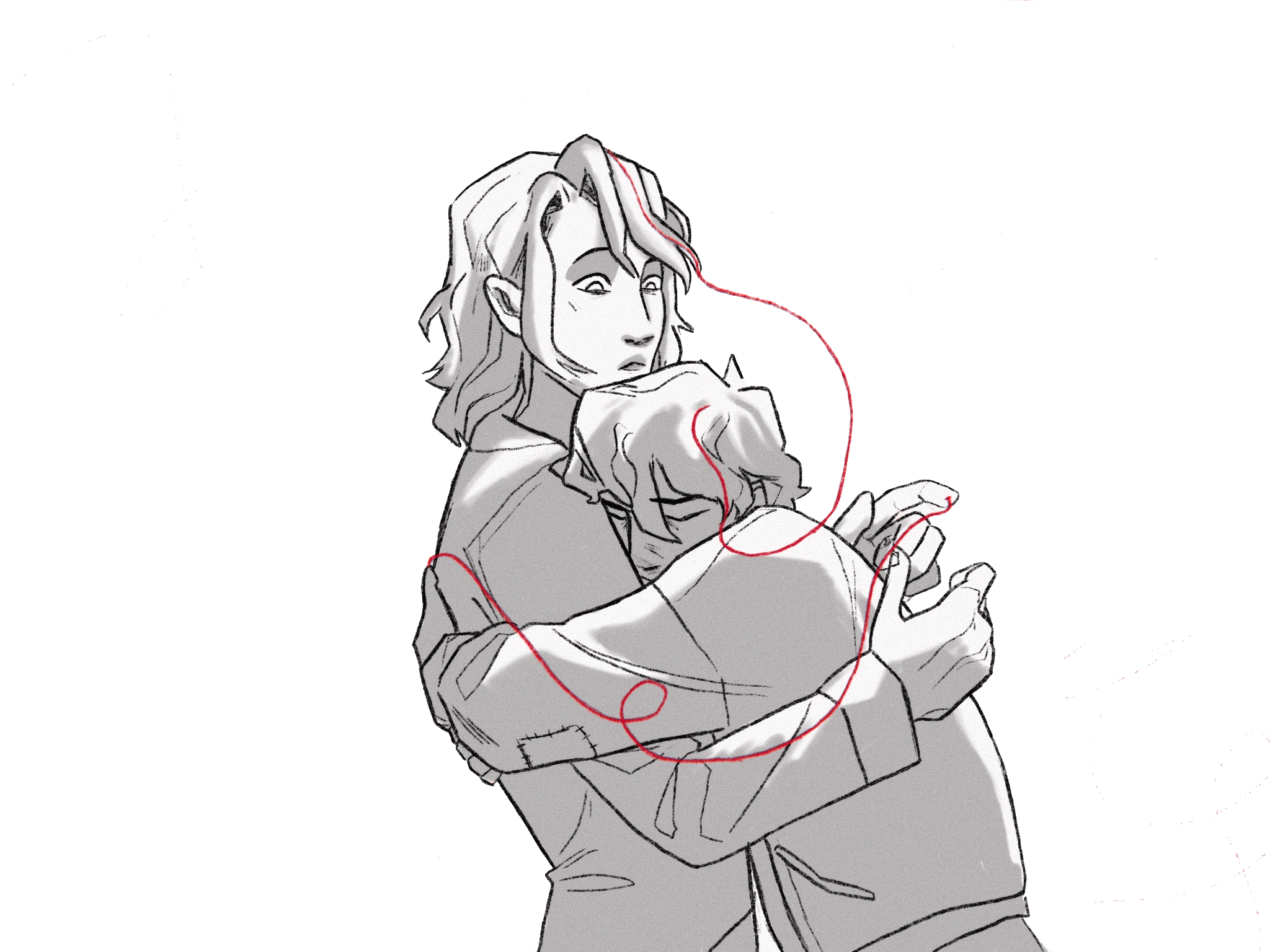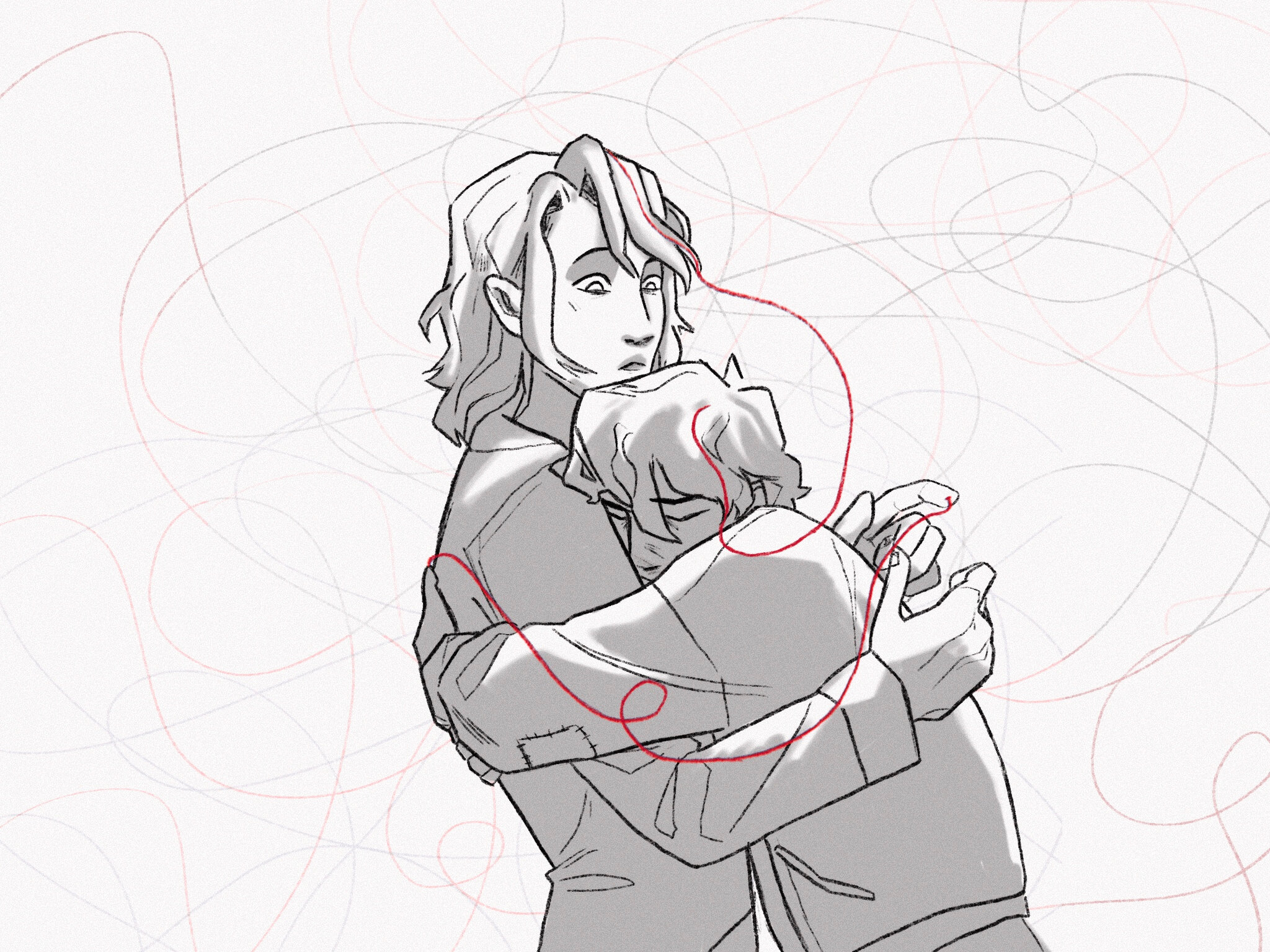Let’s begin with the slice of hair. Waves of brown interspersed with a few blonde strands and a single copper-red streak contributed by my father’s mother. The stylist—Ashley, the only person who’d ever done my hair in our small town—swept it gently into a black ceramic sink that hurt the back of my neck as I craned my shoulders toward the spout.
Ashley lathered, conditioned, dried. As I perched on her spinning stool, she carefully brushed my hair into five subsections, wrapping a tiny colored band around each. Before she made the cut, she asked me if I was sure. I said yes.
There was a jar of scissors and a curler set on the tabletop of her workspace; she plucked out a thin pair of blades with a black plastic handle. Her hands were gentle on my head. She placed each curl of hair into a clear plastic Ziploc bag and handed it to me when she was done. “Try Locks of Love,” she told me, “I’ve heard they’re good.”
There was no preamble the last time I went: the stylist pulled my hair back with one hand and wielded her scissors with efficiency. Snip snip, ponytail falls.
I read later on the website for Wigs 4 Kids that you lose a few inches of hair if you choose the one-cut way; something to do with the strands that get pulled in from the side of the scalp being shorter. I just remember the shock, like jumping into Payette Lake from a cliffside in summer, cold water closing over my head. No warning: just a sudden lightness, a desire to run my fingers through the ruffle of what was left.
It was mid-July. As I sat on the curb outside, waiting for my mother to emerge from the antique store next door, I took note of the breeze tickling my bare shoulders. I looked through organizations on my phone and decided to send my eight inches to Michigan.
Hair is annual—my hairstyle follows the seasons, short in autumn and getting long enough to send off by spring. Blood, on the other hand, is a bimonthly affair—eight weeks, if you’re being precise.
It used to be irregular. I’d see a blood drive and put my name on the list if I had the time. Walk up to the foldable table in the college commons and fill out my details on an iPad before taking a seat on a portable chair, my punctured arm laid out for any passersby to see.
Then I transitioned to the local donation center. When I arrive for my donation, they take me to a private room with frosted windows and prick my finger to check my iron levels. They have plushy chairs, experienced staff, and snacks. Sometimes I wonder if half the reason I go is for the snacks; I never feel guilty guzzling down a V8 and a half dozen packets of cookies and chips after I’ve proffered my arm for the needle.
The last time I went, I was the final appointment of the day. The staff joked with each other as they finalized paperwork and labeling. I listened as I squeezed the ball that was supposed to help the woman find my vein. I didn’t look when she pierced my arm—not like my first time, at sixteen years old.
Back then, I watched as the needle went in. Maybe to convince myself I was brave enough to see it. It wasn’t as painful as I’d expected; I remember fascination as I watched the sample vials they took before the donation itself fill with red. My red.
But not mine anymore. If the hair I give is already dead, the blood is somnambulant, if severed from me much the same. Sleeping in between hosts before it wakes again.
I get texts after my donations when my blood is used: its arrival at a hospital, its imminent transfusion. I imagine almost a dozen tiny threads sewn between me and anonymous recipients. Lifeblood ties, I’d like to imagine, though I sometimes wonder if my blood has ever gone to someone for whom it wasn’t enough.
A 2014 study showed that blood donors scored higher than non-donors in the area of “impure altruism,” donating both to benefit others and to gain a “warm glow” for themselves. I try to envision how much of my drive to donate comes from a desire for that warm glow. After all, I wear the colorful band the staff uses to patch me up afterward like a badge of honor. Later, I get my text, smile at my phone, and go on with my life.
I’ve only realized recently how alienated my experience is from the recipient. Just like my hair, I never see where my blood ends up.
Hair was fourteen, blood was sixteen, and on the top of my Notes app list for “Things to do when I’m 18,”just below “sign my own permission forms” and above “get ordained online,” was “sign up for the bone marrow registry.” Bone marrow was a step up: I know the needle is bigger, know it digs deeper.
But I’ve also done my research. I know that bone marrow donation is a low-risk procedure. I know it can save a life—leukemia patients are the target, I think. I know that being a match for someone is heavily dependent on ethnic background. Which means the likelihood for someone mixed like me, someone relatively unique on the genetic scale, needing a transplant is low.
Still. I wouldn’t want to be on the other side of the aisle, waiting for a match I don’t think will ever come. So on my eighteenth birthday, I registered online. I sent them my cheek swab. My name is still on their list; I keep my contact info updated. Just in case.
Here, we reach my limit.
I thought briefly about donating eggs back in my first year of college. I remember late nights in my lofted twin bed as I scrolled through pages of information about the process, pictures of smiling women with height and heritage and SAT scores listed next to their headshots. I considered myself among them and eventually closed out the web pages, unease twisting in my stomach. I still can’t imagine my face living on in a child I will never get to meet.
After eggs on my self-made scale comes the liver. It was cold and wintry when one of my friends mentioned that you could make a living donation of the organ. He joked that he drank so much he wasn’t sure they’d take his.
You can donate over half your liver and the rest will grow back, for both you and the recipient. Livers are hardy like that, and I know mine’s healthy; I wouldn’t touch alcohol with a ten-foot pole.
But liver donation also entails surgery. A surgery I’m not so sure I’m ready to undergo—not for a stranger.
Kidneys are similar. Is it selfish to want both for myself, just in case one fails? I can always make more hair, more blood, more marrow, even more liver. But once a kidney is gone, nothing fills the space it leaves behind.
If I die young, let’s hope it’s quick and leaves me mostly intact. The little heart at the corner of my driver’s license tells what can be taken: one life, perhaps, for the lives of a few strangers. One body for many organs: heart, lungs, kidneys. Apparently, sometimes they take eyes. I don’t know how that would feel, my eyes in another person’s face.
How far would I let them go? Do my wishes matter if I’m not alive to speak them? I wonder what they’d be able to do someday with my tongue.
We began with the slice of hair. I wonder sometimes about the slice of soul. The severing of myself from my body. I don’t know what follows. But when my time comes, blood cooling and neurons finished firing at last, I can at least let my shell serve the people I leave behind.
Tonight, I can feel the chill of my room through my jacket; I left my window open too long, trying to even out the temperature ratcheted up by my overactive heater. My fingers across my keyboard are hesitant, my thoughts winding down.
But giving is complicated. I know that I am not a wholly altruistic person. (I would argue that nobody is.) This year, I’ve found myself encouraging friends to sign up for blood donation appointments or add their names to the bone marrow registry. I can feel two motivations pulling at me. One says remind them to donate. Look, we are saving lives. Look at how much you can help others to give.
The other says remind them to donate. Won’t they think you’re selfless? Won’t they think you’re kind?
Even this essay feels in some ways like me holding a sign over my head for the reader: OBSERVE MY ALTRUISM, PLEASE. And as much as I’d like to avoid that connotation, I’m afraid it might always taint—or, perhaps, shed light upon—this piece of work.
It’s all so very complicated. How much of giving is a mutual joy, and how much is just a gift to yourself?
Still. Does it matter to the person on the other end? If I consider the long train of donations, I realize that even though my organs might be plucked from my body when I die, the people who receive them will someday meet their end just the same. All we can give each other, ultimately, is time.
A little bit of extra time before that moment comes.

